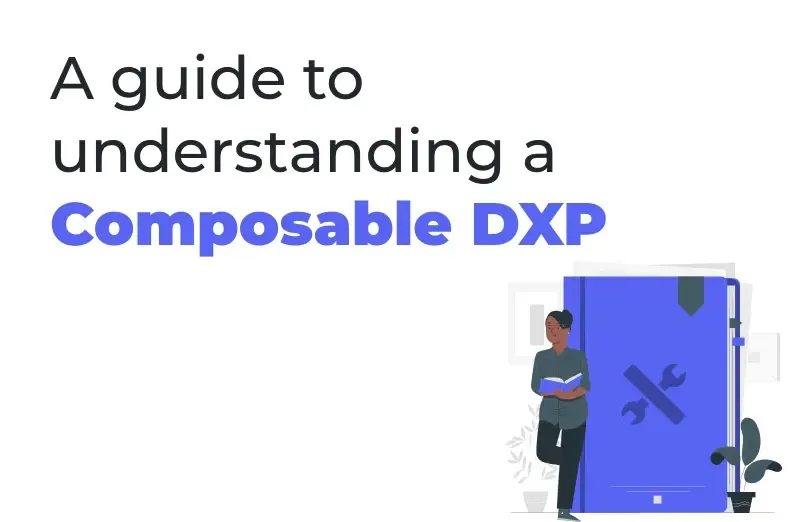A guide to understanding a Composable DXP
Published: 28 February 2023

In this blog, we will explore in detail what a composable DXP is, its features, and key benefits as well as how organizations can leverage a DXP to create personalized, engaging digital experiences.
Today, the customers are increasingly demanding more and more personalization when it comes to digital experiences. This is of course easier said than done. Implementing a completely personalized system for your customer journeys can be quite a task.
There are many challenges that brands have to face when talking about personalization. Fortunately, brands can augment, amplify as well as scale the customer experience through a Digital Experience Platform.
This will allow them to keep the customer journeys smooth, straightforward, and most important of all, personalized. A DXP is an integration of various technologies brought together to combine the capabilities of e-commerce, content management, personalization, and localization. A DXP is used to continuously deliver omnichannel experiences.
What is a composable DXP?
A composable DXP is a modular DXP which is comprised of cloud-native and best-of-the-best SaaS products. It is a comprehensive suite of software tools and services that enables organizations to design, deploy and manage a range of digital experiences across multiple digital channels and touchpoints.
When it comes to a composable DXP, the brands and businesses get access to different functions such as asset management and engagement tools.
How does it work? A composable DXP leverages open-platform MACH architecture and integrates via APIs to connect both the internal and external systems. This makes it easier for the developers to simultaneously make changes to both front end and back end.
This way, there is an improvement in the administrative efficiency and also continuous deployment can be run without any downtime.
What does a composable DXP look like? Some of the core functions of a composable DXP apart from featuring a powerful CMS are:
- Contextual intelligence and relevance
- E-commerce
- Digital asset management
- Engagement with users
- Digital processing
- Cognitive and analytics
- Data center
What are the benefits of a composable DXP?
1. It establishes an intelligent architecture.
Using a composable DXP, marketers and developers can make changes easily in both front end and back end simultaneously. This improves efficiency and supports the continuous deployment of all the applications of all business departments.
2. It creates a control center that is integrated.
You can integrate solutions across the organization that is marketing, sales, etc., and get full control of the content management, customer data, and analytics using the composable DXP. This way, you can increase customer retention by driving connected and consistent customer journeys.
3. Time to market is accelerated.
There is a significant administrative advantage because of which when the brands adopt the composable DXP can deliver new features faster.
4. Enhanced content flexibility and optimization.
A composable DXP has robust testing capabilities which enables the marketing teams to track the assets and the performance of campaigns. This improves the optimization capabilities of brands.
5. Customer visibility increases significantly.
You can integrate all systems that connect the customers to enable a 360-degree view of each customer using the composable DXP.
6. You can optimize customer touchpoints.
Brands can leverage a composable DXP to re-engineer policies, processes and maximize customer satisfaction. You can deliver extraordinary experiences to all customer touchpoints such as mobile, social media, mobile, e-commerce, chatbots, portals, etc.
7. You can future proof your business.
Using a composable DXP you can adapt to the target audiences and replace or upgrade tools. This way, your brand has flexibility even in the future if there are changing trends or advancements in technology.
What are the features of a composable DXP?
A composable DXP is the wiser choice for any business rather than going for the traditional DXP. Some of the key features are:
- It is built on a modular architecture that allows brands to add, replace or remove components based on the changing requirements.
- It is API-driven which means it allows you to integrate third-party tools, applications and services onto your platform.
- It is highly scalable and meant to handle large volumes of traffic and transactions without crashing or slowing down your website.
- A composable DXP provides you with detailed analytics into the user engagement and customer behavior.
- The robust features of a composable DXP ensure the safety and the privacy of the user data which is essential for brands and businesses dealing with customers and their demographic details.
Conclusion
In brief, a composable DXP is flexible, functional and drives personalization which is fully efficient and optimized. Personalization is no longer just something that is nice-to-have but an important aspect when it comes to customer experiences.
Personalization has become a fundamental aspect and factor that determines the customer's journey. Even in B2B businesses, personalization now matters more than ever. By getting a composable DXP, you can generate invaluable business intelligence to make faster and smarter decisions.
Sitecore offers not just a CMS but now a fully composable DXP. It seamlessly combines content, experience and commerce to deliver a suite of composable products for elevating customer experiences.
Here is a list of products of Sitecore that serves these solutions:
- Sitecore OrderCloud – Commerce merchandising and storefronts
- Sitecore Discover – Commerce product discovery
- Sitecore Content Hub – Content management, operations and digital asset management
- Sitecore CDP – Customer data management and marketing
- Sitecore Send – Marketing automation and email marketing
You can choose either of these products to integrate components required for your business.

Maulik Dudharejia - Co-Founder & CMO - ADDACT
Sitecore MVP 3X || Digital Transformation Strategist || Marketer
Maulik Dudharejia is a visionary author, co-founder, Chief Marketing Officer, and a digital transformation expert with over 12+ years' of experience. He leverages industry certifications to translate complex tech concepts into engaging writing. His areas of expertise include Sitecore, IoT, and IT Service Management. Maulik offers valuable insights and strategies to help readers navigate the evolving tech landscape.
